Close
Local and new selection grape varieties

Local Moldovan grape varieties include Rara Neagră, Feteasca Neagră, Feteasca Regală, Feteasca Albă.
New selection varieties include Alb de Onițcani, Codrinschi, Viorica, Legenda and Riton.
Local Moldovan grape varieties
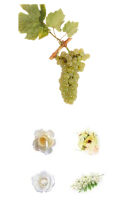
Feteasca Alba
This is an ancient variety cultivated in the region for centuries. It stems from the Fetească Regală “parental” variety (along with the “Frâncușa” variety), originating from Transylvania, Romania, and has been cultivated in the Republic of Moldova for a number of decades before the appearance of phylloxera in the country. Wines produced from these grapes are fine and delicate, light, and fresh, with floral aromas. It is cultivated in most regions of Romania, Moldova, Hungary, Ukraine, Germany.
Parental forms: It is a white clonal variation of the indigenous variety Feteasca Neagra originating in the area of Moldova in Romania.
Synonyms: 52 synonyms, Poama fetei, Fetița, Păsăreasca albă, Leanca etc.
The Feteasca Alba vineyard area occupied in Romania is over 10000.0 ha.
The area covered by this variety in the Republic of Moldova (registered in RVV, 30.12.2019): 651.0 ha, including 370.0 ha registered for the production of wine products with PGI. It occupies the first place among the indigenous varieties by area.
The Feteasca Alba grape variety is excellent for the production of dry, semi-dry, semi-sweet and sparkling white wines.
The wines produced from Feteasca Alba grapes are fine and delicate, the aroma is reminiscent of the scent of vines, acacia flowers, wildflowers, citrus, green apple, light and fresh.
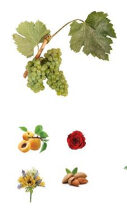
Feteasca Regala
This variety was found in the 1920s near Sighișoara, Romania. It is a semi-aromatic variety that is the result of natural crossbreeding. The characteristics of this grape variety are a floral and grapefruit aroma with fresh pear and citrus nuances. These grapes, however, usually, have a much fuller and textured taste than their parent varieties.
Parental forms: crossbreeding of Feteasca Alba and Grasa de Cotnari.
Synonyms: 32 synonyms, Dănășeana, Galbena de Ardeal, Feteasca muscatnaia, etc.
It is cultivated in most regions of Romania, Republic of Moldova.
The area of the Feteasca Regală vineyards occupied in Romania - 12639.32 ha
Variety area, occupied in the Republic of Moldova (registered in RVV, 30.12.2019): It occupies second place among the indigenous varieties by area and constitutes - 299.0 ha, including 72.0 ha registered for the production of wine products with PGI
Grapes of this variety have a typical floral and grape-fruit aroma, with shades of fresh pear and citrus, but usually have a more full-bodied and textured taste than their "parents". From Fetească Regală you can obtain medium-bodied wines for those kept in stainless steel and full-bodied wines for those kept in barrel aging, with intense aromas and a great aging potential. The fine tannins in the skin of the grapes contribute as a resistance factor to aging.
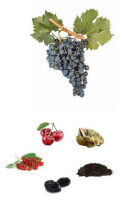
Feteasca Neagra
It is thought that this variety is more than 2000 years old and has its origins in the Prut River valley in the south-western part of the Republic of Moldova. It is believed to have been cultivated directly from wild plants. The grape is able to produce high quality red wines with wild, purple cherry aromas, characterised by a concentrated berry taste and a good structure. Seeds of Fetească Neagră were discovered in ancient vestiges discovered in Romania, more than 2000 years old.
Parental forms: Recent DNA profiling has suggested that the variety is not a mutation of the white Feteasca Alba variety that is also widely planted in Romania, as was previously thought. There are at least four different types of Feteasca Neagra; these mutations suggest the grape variety is relatively old in its own right.
Synonims: Swallowtail, Black Bird, Black Face Grape (RO / MD), Chornaya Fetyaska (RUS), Fekete Leányka (HUN), Mädchentraube Schwarz, Schwarze Mädchentraube (DE).
Feteasca Neagra is cultivated, especially, in the viticultural regions Muntenia and Oltenia Hills, Moldavia Hills, Banat, Crisana and Maramures, Dobrogea Hills, Danube Terraces and Transylvanian Plateau. Feteasca Neagra is one of the most cultivated varieties in the Republic of Moldova.
The area of Feteasca Neagra vineyards occupied in Romania - 2971.9 ha
Variety area, occupied in the Republic of Moldova (registered in RVV, 30.12.2019): It occupies the 3rd place among the indigenous varieties by area and constitutes - 242.0 ha, including 54.0 ha registered for the production of wine products with PGI.
From this variety can be obtained both special rosés and red wines that can be aged in quality wood and later in glass, resulting in wines of great brand, with a pronounced typicality.
Aromatic profile - aroma of berries, cherries, plums, black raisins, slightly spicy, reminiscent of cinnamon, black peppercorns, allspice, or vanilla, and is richer and finer with age.
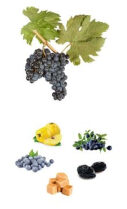
Rara Neagra
This is an old variety of grapes that is thought to having been cultivated in south-eastern Romania and on the present territory of the Republic of Moldova as early as the Geto-Dacian times. It has a relatively pale colour, with delicate, light tannins and a taste of spicy berries. It has acclimatised particularly well on the sunny hills of southern Moldova.
Scientific data (P. Ungureanu, 1960, P. Macarenco, 1988) indicates that the Rară Neagră variety has been cultivated since ancient times in many localities in Moldova. The best and most famous wines of this variety were obtained in the localities of Purcari, Răscăieți, Leuntea, Talmaza and Căușeni - all from the area delimited for the Ștefan Vodă PGI.
Rara Neagră was included among the first in the catalogue of plant varieties of the Republic of Moldova in 1946.
Parental forms: result of popular selection, the age of this grape variety is from the Geto-Dacian period.
Synonyms: Băbeasca neagră, Căldărușa, Rășchirata, Serecsia, Crăcănată, Neagră băbească etc. In Romania since 1950, the name Băbească Neagră has become wide-spread, in Moldova - Rară Neagră, and in Ukraine and the USA this variety is called Sereksia / Sereksiya.
Among the favourite wines of Stefan cel Mare was the wine of this variety produced in Nicorești (currently Galați).
It is cultivated in Romania, Moldova, Ukraine, United States of America. The global area occupied with this variety is about 2300.0 ha.
Variety area, occupied in the Republic of Moldova (registered in RVV, 30.12.2019): It occupies the 4th place among the indigenous varieties by area and constitutes - 102.0 ha, including 24.0 ha registered for the production of wine products with PGI.
The wines obtained from the Rara Neagra grape variety are light wines, less extractive with fine tannins, dominant aromas of rosehip flower, red currant, wild blackberries. Due to its high acidity, Rara Neagra is suitable for obtaining rosé and red sparkling wines, unique in taste and aroma.
New Selection Grape Varieties

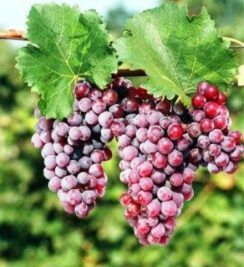
Legenda
Country of origin: Republic of Moldova, created in 1975 by the National Institute of Winemaking and Viticulture of the Republic of Moldova.
Surveyed and categorised in 2003, entered into the IȘPHTA collection of varieties and in the Registry of Plant Varieties of the Republic of Moldova.
Authors: N. Guzun, P. Nedov, B. Găină
Parental forms: crossbreeding of the Royal Vineyard table variety (England) with the pink Traminer variety (Austria).
Synonyms: Moldovan Traminer (unofficial).
The area covered by this variety in the Republic of Moldova (registered in RVV, 30.12.2019): No registries of the Legend (unofficial 10 ha) areas exist.
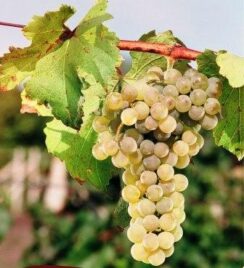
Viorica
The “Viorica” variety is classified as an aromatic variety.
Country of origin: Republic of Moldova
Parental forms: The Viorica’s grape parents are considered to be a hybrid of French origin, Seibel 13-666 (the maternal) and an Italian variety, considered a red Muscat, Aleatico (the paternal). Both parents are red varieties. Seibel is part of the category of hybrids created via crossbreeding of wild vineyard cultures from America and Europe. The creation of these hybrids was intended to obtain resistance to temperature, to various cryptogamic diseases (caused by grey rot, manna powdery mildew, etc.) and to harmful insects such as phylloxera.
Dates back to 1969, researchers - Guzun N., Olar F., Tsypco M., Konovalova A., Nedov P.
To be noted that these hybrids contain no malvidin diglucoside concentrations exceeding the legal limits set by the EU and consequently pose no danger to a consumer’s health.
The Viorica grape is included in the Catalogue of plant varieties of the Republic of Moldova under the category of white wine varieties. Additionally, the Viorica (Wiorika) variety is also entered as a Wine Variety into the International Catalogue of Grape Varieties. The Viorica grape is planted in the territory of Moldova, but is also found in other countries in the region such as Ukraine, Russia, Czech Republic, Hungary, and Bulgaria.
The area planted with this variety in the Republic of Moldova as indicated in RVV, 30.12.2019: The Viorica grape occupies an area of 95 ha in the country, including 26.0 ha registered for the production of wine products with PGI (unofficial - 152.7 ha).
The name of the grape variety Viorica shall not be confused with the name of a former Soviet wine blend consisting of Fetească Albă, Rkațiteli, Riesling and Cabernet Sauvignon. As mentioned, the Viorica wine inherited the paternal character of the Italian red, fragrant variety Aleatico.
Viorica dry wine has a straw-yellow colour with green reflections. The aromas are of intense white flowers, specific for the Muscat variety, such as acacia flowers, jasmine flowers, and linden flowers. Some additional hints of citrus, lychee, yellow apples, and candied apricots could be also present. Note touches of thyme, basil, and other dried herbs may be felt.
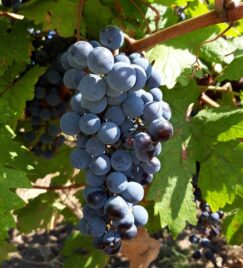
Codrinschi
Country of origin: Republic of Moldova, created by Moldovan scientists between 1955 – 1975.
After 40 years of research and observations on its evolution, the Codrinschi variety was approved and entered into the Catalogue of grape varieties across the Prut River, in 2005.
Parental forms: crossbreeding of the Cabernet Sauvignon and Rara Neagră varieties.
The area under this variety in the Republic of Moldova (registered in RVV, 30.12.2019): The Codrinschi variety occupies an area of 152.9 ha.
From its noble parents Cabernet Sauvignon and Rară Neagră, the Codrinschi variety inherited a well-defined structure with a high concentration of phenolic substances, especially, in young wine (2,048mg/dm³), as well, as a high content of anthocyanins - 507mg/dm³ high extract. This places it somewhere among Cabernet Sauvignon and Merlot varieties.
Codrinschi wine develops aromas of ripe black sweet fruits such as cherries, blackberries, and black currant, enriched by notes of floral aromas, violets, and dried leaves. De-pending on the maturation time and on the barrels used, it can include notes of vanilla also.
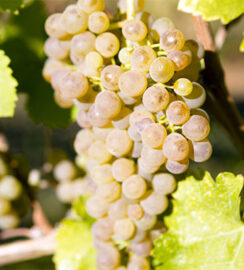
Alb de Onițcani
Country of origin: Republic of Moldova
Parental forms: Obtained in 1960 by pollination of the Cili Chiuliabi variety (grape variety from Dagestan) with a mix of pollen from Sao Villar 20-336 and Seianeț 244 (the second descendant of the Pinot Blanc variety).
In 1976 it was accepted for state testing of plant varieties.
Alb de Onițcani variety was obtained by a group of researchers from the Agricultural Institute of Chisinau and the Viticulture and Winemaking Research Institute of Scientific Production Association “Vieru”.
Authors: D. Verderevschi, C. Voitovici, I. Naidenova
The area planted with this variety in the Republic of Moldova (registered in RVV, 30.12.2019): The Onițcani variety occupies an area of 242.6 ha, including the 202.0 ha registered for the production of wine products with PGI.
The Onițcani variety was used mostly for the production of distillates. At present, good quality dry wines are being produced following the recent climate change.
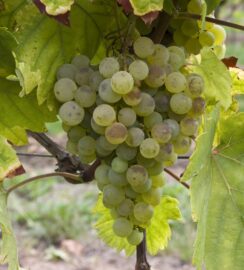
Riton
Country of origin: Republic of Moldova, approved in the 2000s.
Parental forms: One of the parents of this variety is Villard Blanc - a French hybrid, created by horticulturist Bertille Seyve with the purpose of resisting cryptogamic diseases. Villard Blanc is also called Seyve Villard 12,375. The second parent would be Rhin Riesling.
It is a new selection variety, the youngest one that has been researched the least, but with great future potential.
Area planted with this variety in the Republic of Moldova (registered in RVV, 30.12.2019): Riton occupies an area of 174.5 ha.
The wines from the Riton variety have a complex aroma with an invigorating, mineral freshness.
/ Follow us
/ Subscribe to news
/ Wineries / Tourism / Wine History / About ONVV / News
MD-2004, Republica Moldova, mun. Chișinău, str. Sfatul Țării, 59
office@wineofmoldova.com, tel. 022 105 560
Copyright © Oficiul Național al Viei și Vinului (ONVV). All rights reserved. Privacy Policy